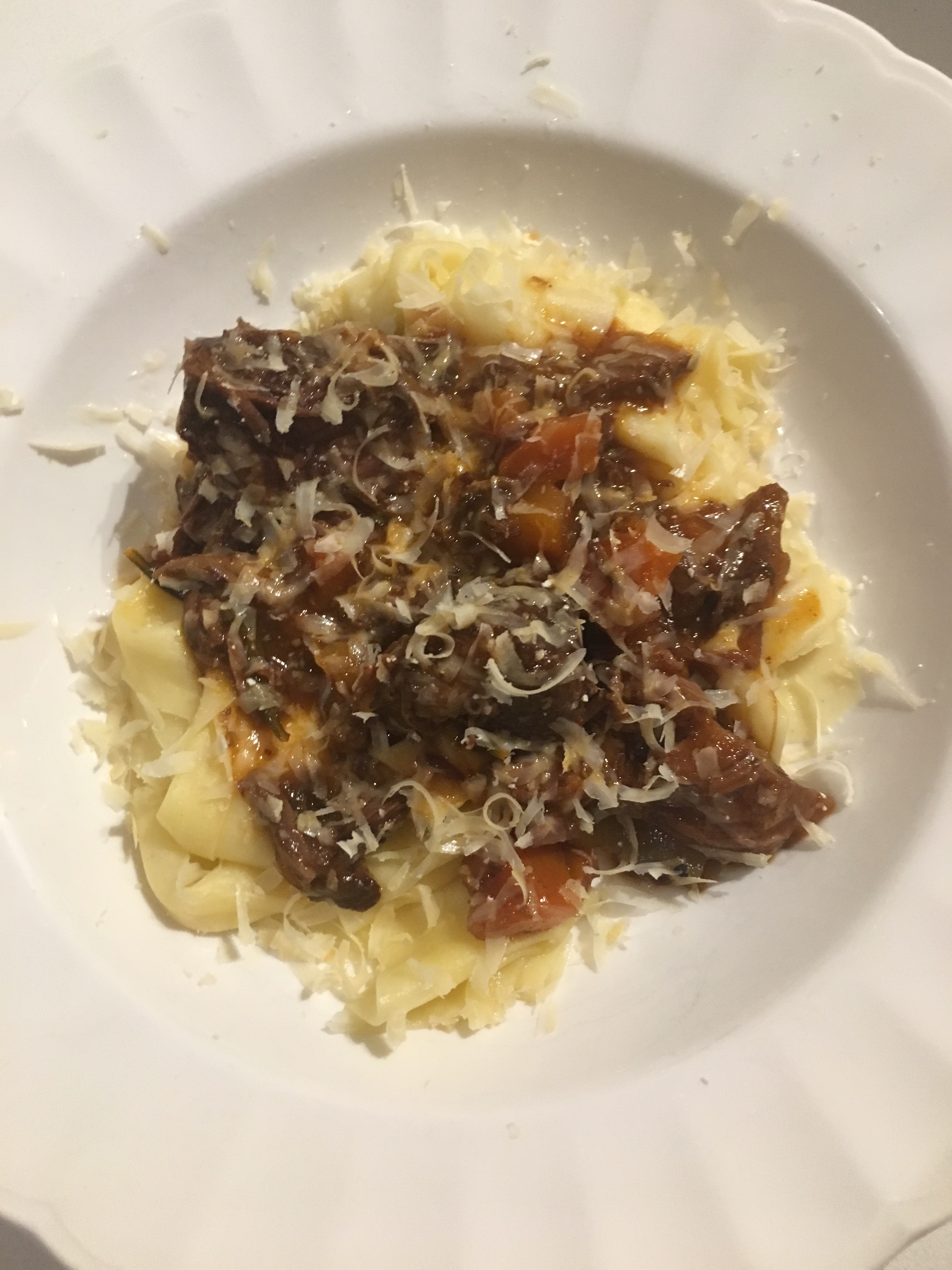

Sources:
http://jamie oliver slow-cooked beef cheek ragu
https://www.jamieoliver.com/recipes/pasta-recipes/royal-pasta-dough/
Ingredients
Slow-cooked beef cheek ragù
- 20 g dried porcini mushrooms
- 5 beef cheeks , trimmed
- olive oil
- 150 g piece of higher-welfare smoked pancetta
- ½ a celery heart
- 2 red onions
- 2 carrots
- 5 cloves
- 8 cloves of garlic
- ½ a cinnamon stick
- 1 bunch of mixed fresh herbs (30g) , such as sage, bay, rosemary, thyme, basil, parsley
- 500 ml Barolo red wine
- 1 x 680 g jar of passata
Handmade pappardelle
- 400 g good-quality Tipo 00 flour , plus extra for dusting
- 75 g fine semolina
- 12 large free-range eggs
- 2 tablespoons extra virgin olive oil
Method
To make the ragù, start by preheating the oven to 160ºC/325ºF/gas 3. Cover the porcini with boiling kettle water and leave to rehydrate. Season the beef cheeks with sea salt and black pepper, then brown them in a large casserole pan on a high heat with a splash of oil, turning until well coloured all over. Meanwhile, slice the pancetta into lardons. Peel the celery, onions and carrots, then chop into rough 1cm dice. In a pestle and mortar, crush the cloves with 1 teaspoon each of salt and pepper, then peel and pound in the fresh garlic.
When brown, push the cheeks to one side of the pan and reduce to a medium heat. Add the pancetta and cinnamon, stirring until the pancetta is lightly golden. Drain the porcini, reserving the liquor, then roughly chop and add to the pan with the veg. Tie the herbs together, then stir in with the garlic mixture. Fry for 15 minutes, or until soft, stirring occasionally.
Pour in the wine, let it reduce by half, then pour in the reserved porcini water (discarding just the last gritty bit) and the passata. Fill the passata bottle with water and pour into the pan. Cover with a scrunched-up sheet of wet greaseproof paper and a lid. Cook in the oven for 4 hours, or until the meat is outrageously tender and the sauce has thickened. Taste the sauce and season, if needed, then set aside and keep warm.
To make the pasta, start by making the dough. Pile the flour and semolina into a large bowl and make a well in the middle. Separate the eggs and add the yolks to the well, putting the egg whites into a sandwich bag and popping into the freezer for making meringues another day. Add the oil and 4 tablespoons of cold water to the well, then use a fork to whip up with the eggs until smooth, then gradually bring the flour in from the outside. When it becomes too hard to mix, get your clean floured hands in there and bring it together into a ball of dough. Knead on a flour-dusted surface for around 4 minutes, or until smooth and elastic (eggs can vary in size and flour can vary in humidity; this dough shouldn’t be too wet or dry, but tweak with a touch more water or flour if you need to – use your common sense). Wrap in clingfilm and leave to relax for 30 minutes.
To make the pasta, attach a pasta machine firmly to a nice clean table and divide your pasta dough into four pieces, covering everything with a damp clean tea towel to stop it drying out as you go. One at a time, flatten each piece of dough by hand and run it through the thickest setting, then take the rollers down two settings and run the dough through again to make it thinner. Importantly, fold it in half and run it back through the thickest setting again – I like to repeat this a few times because it makes the dough super-smooth and turns it from a tatty sheet into one that fills out the pasta machine properly. Start rolling the sheet down through each setting, dusting with flour as you go. Turn the crank with one hand while the other maintains just a little tension to avoid any kinks, folds or ripples. Take it right down to the desired thickness, which is about 2mm for shapes like linguine, tagliatelle and lasagne (or pappardelle- like in this recipe). For anything turned into a filled pasta, such as ravioli and tortellini, go as thin as 1mm because when it’s folded around a filling it will double up to 2mm.
Serves 8 as a primo or 4 as a secondo.